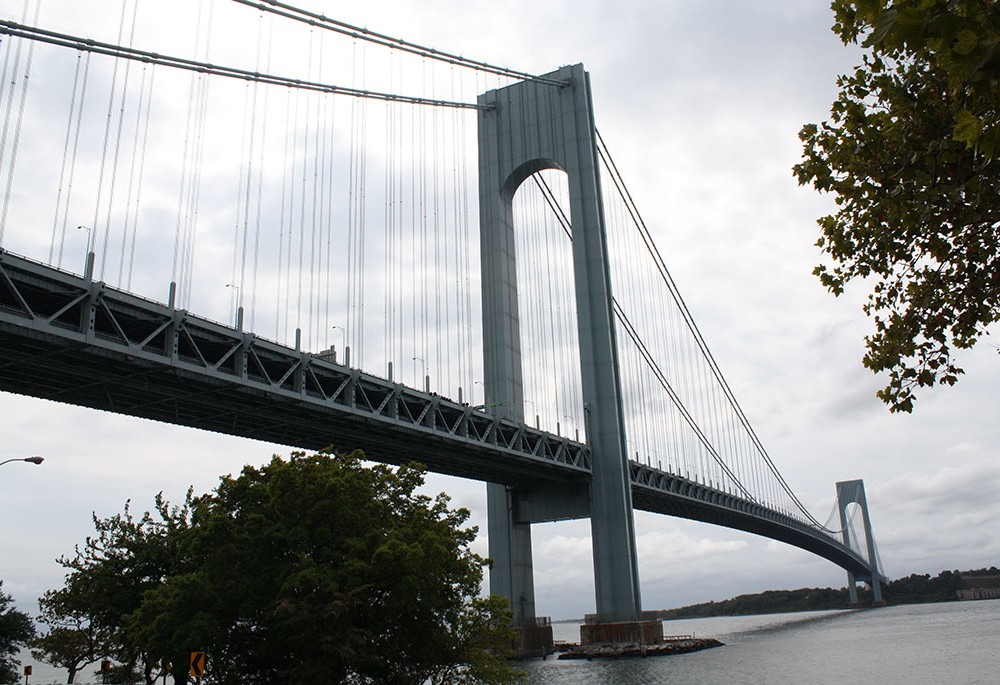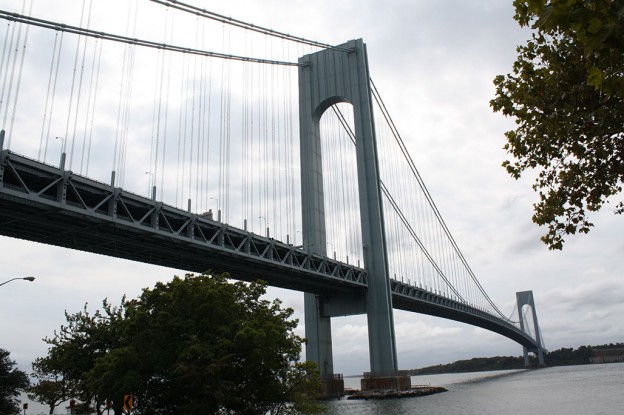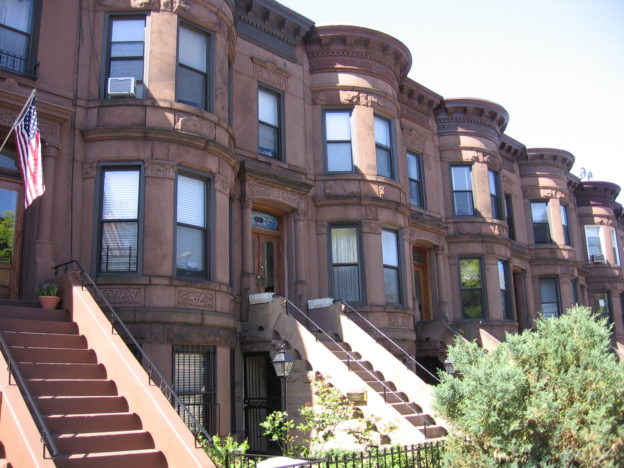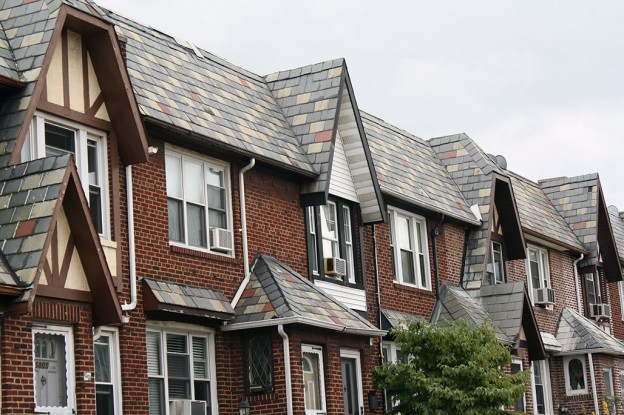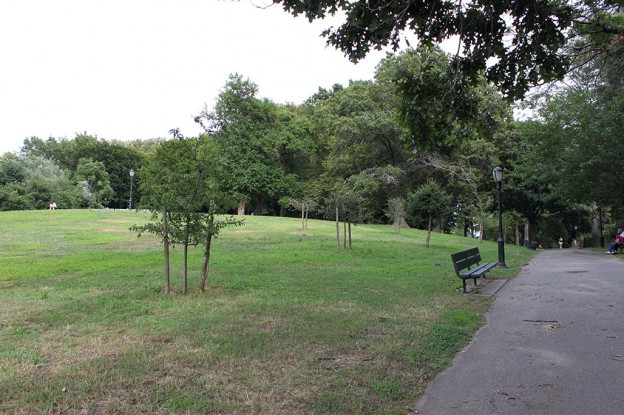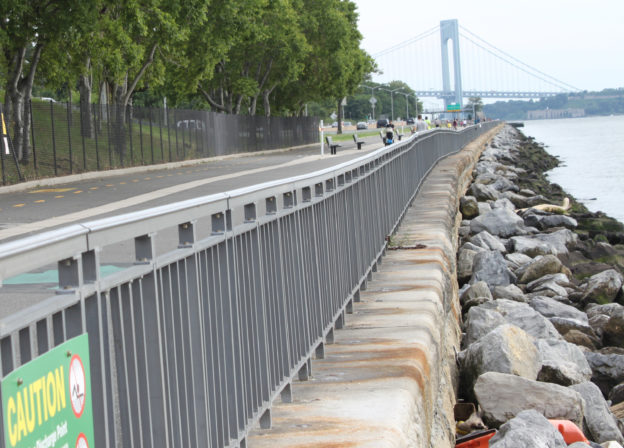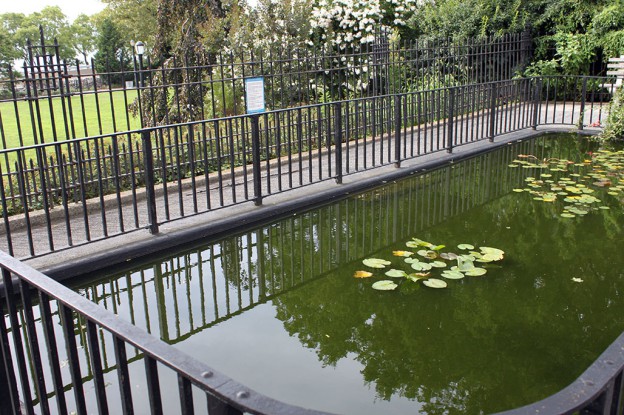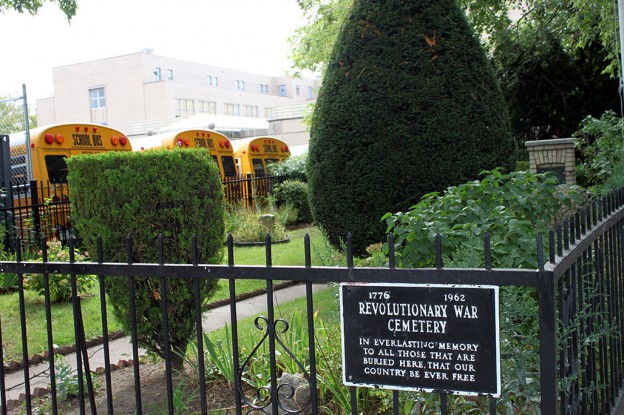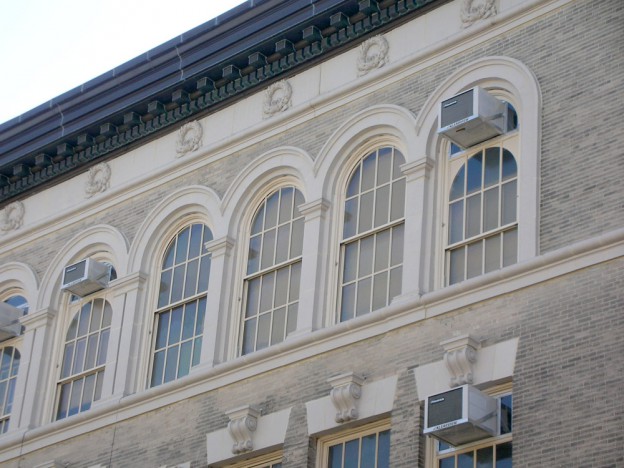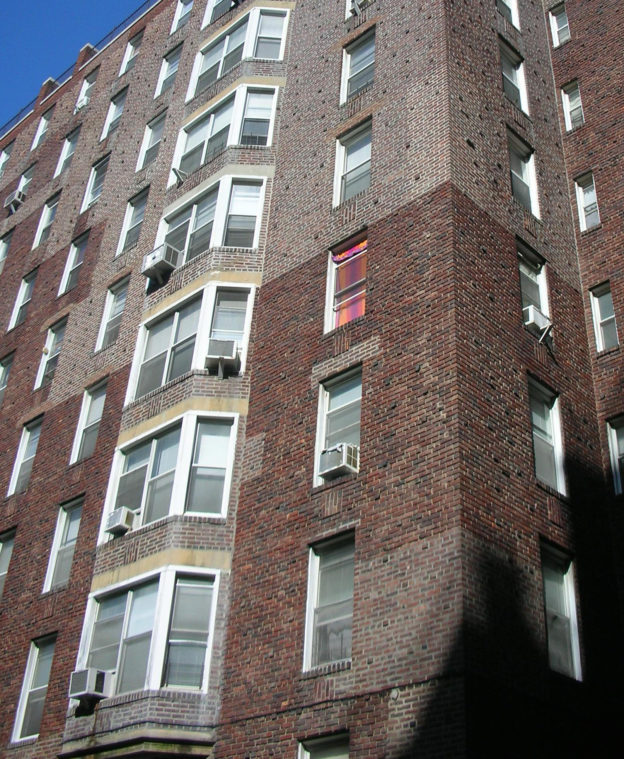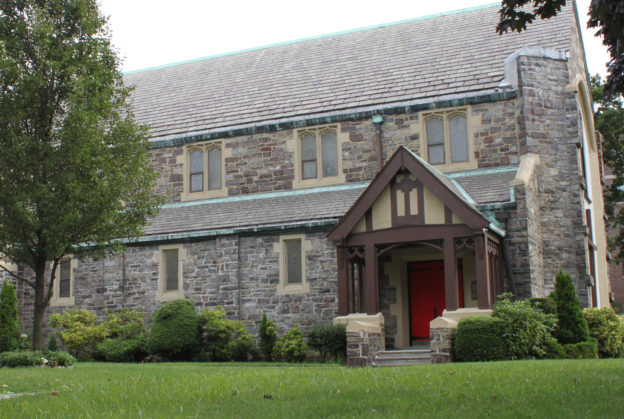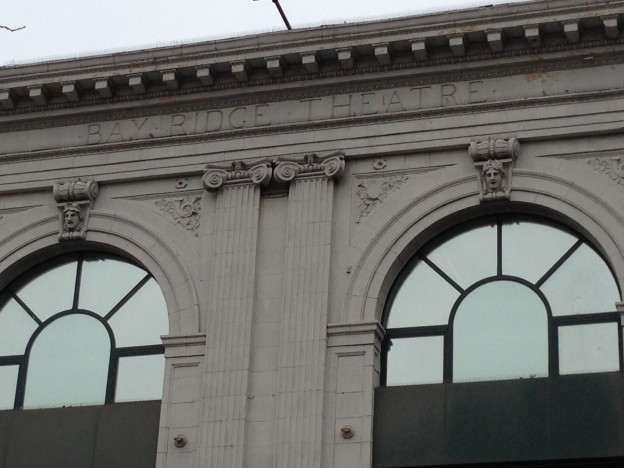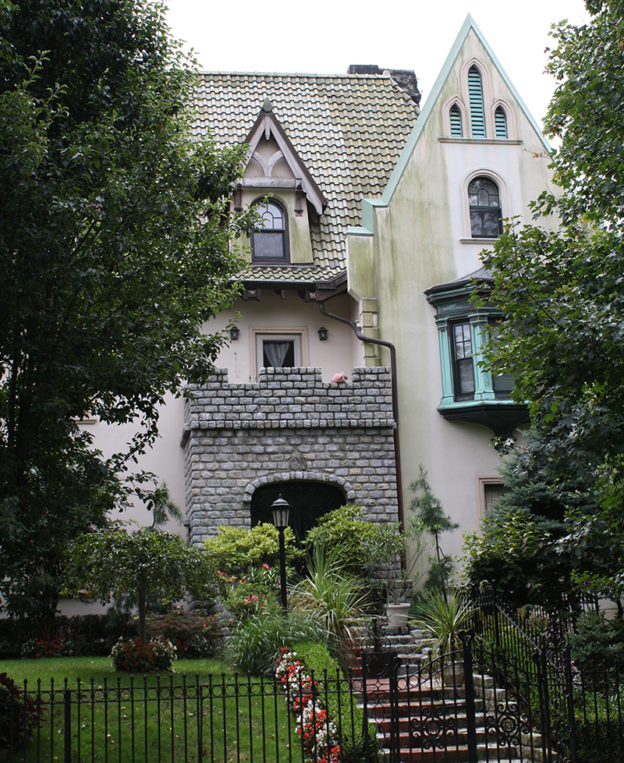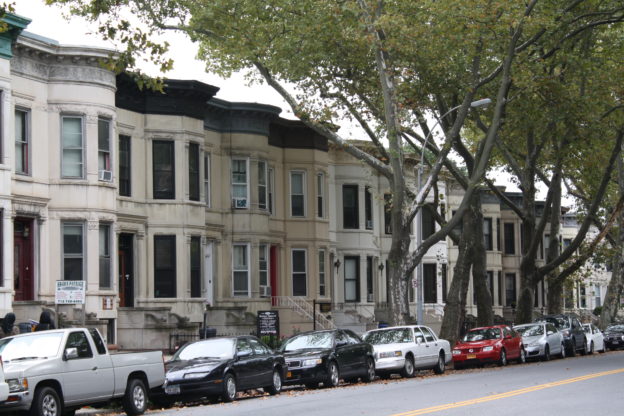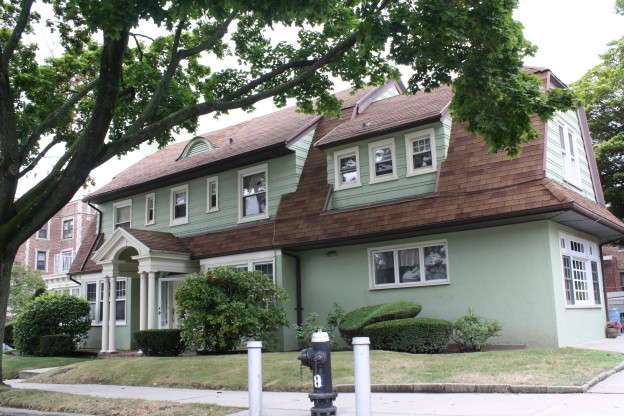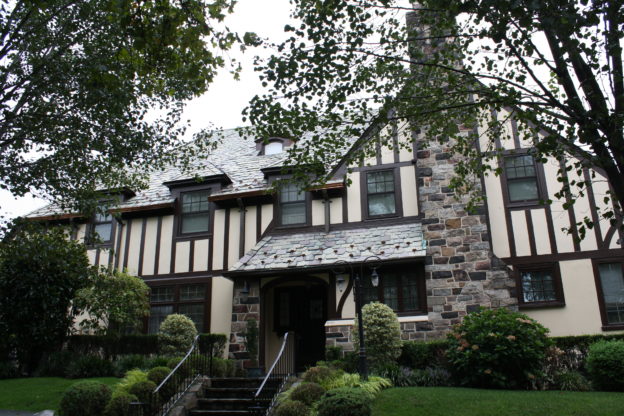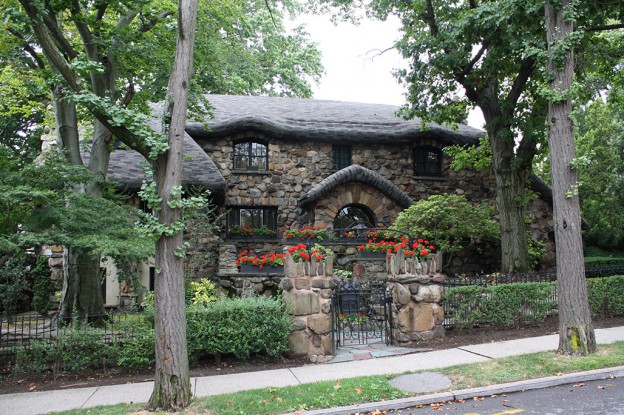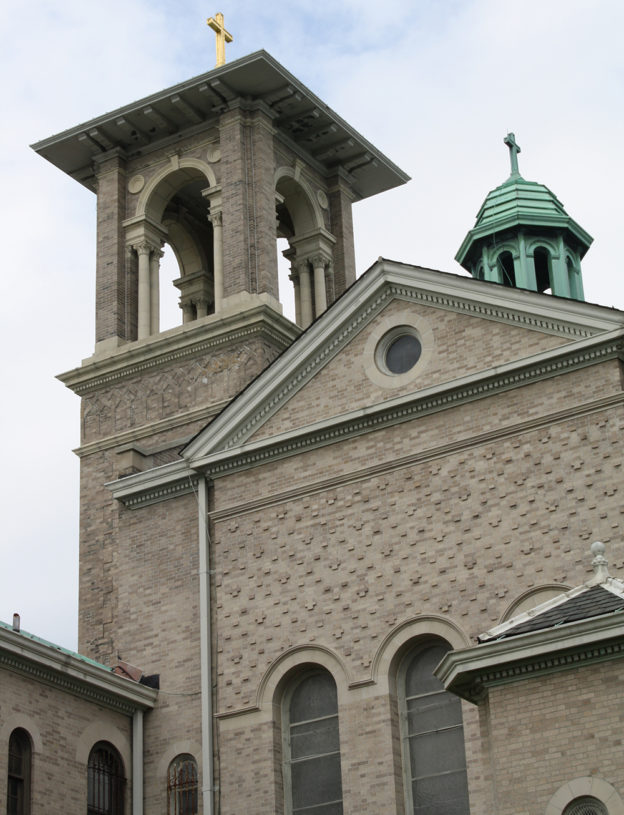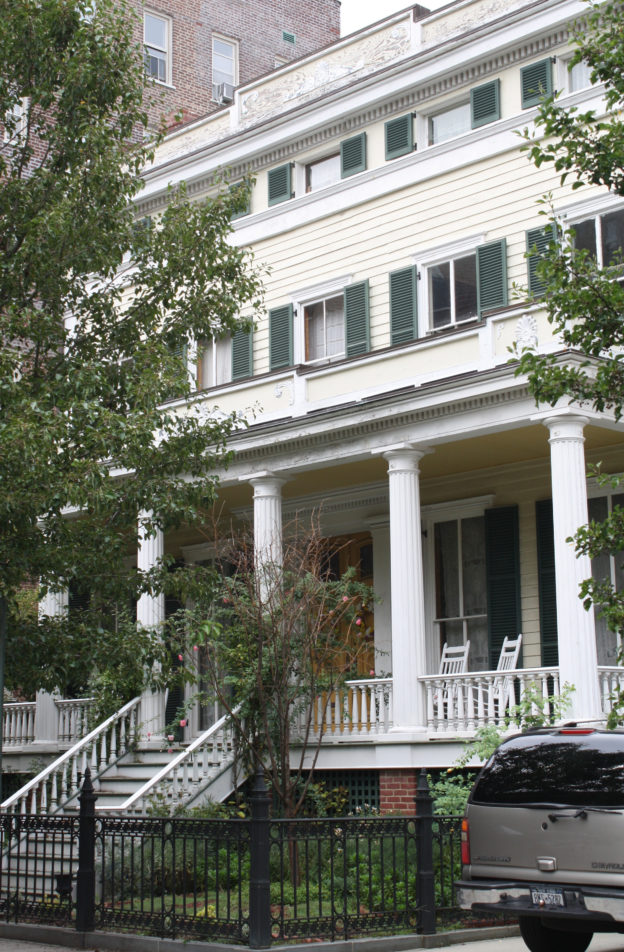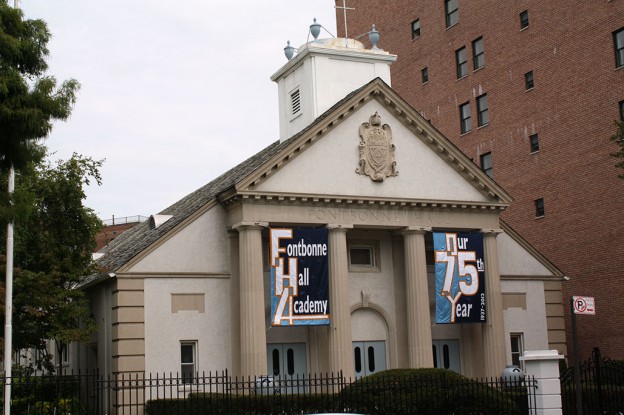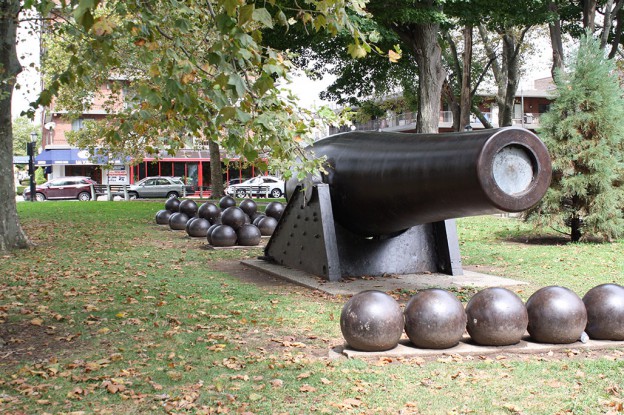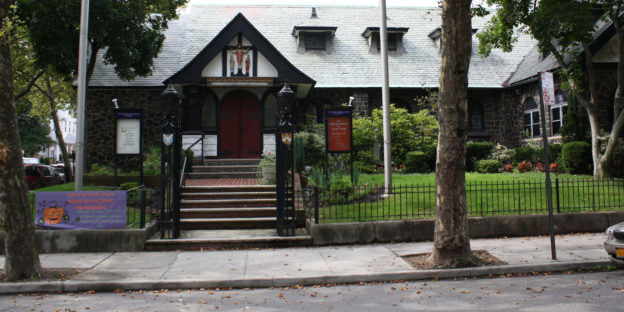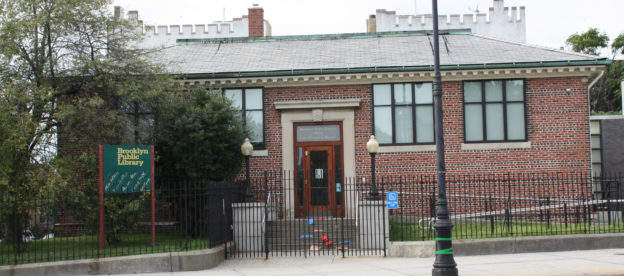Initially developed as a suburban enclave for Brooklyn’s business elite in the decades following the Civil War, Bay Ridge transformed into one of the borough’s most culturally diverse neighborhoods with the arrival of the IRT subway in 1916 and it remains so today. Visitors to this neighborhood will find vibrant commercial districts, cohesive rowhouse blocks, wood frame farmhouses, Victorian mansions, beautiful churches, pre-war apartment buildings, and quaint cul-de- sacs.
To learn more about Bay Ridge click here
Fred W. Eisenla, 1906–12;
State and National Registers of Historic Places|
One of the only brownstone blocks in Bay Ridge, this stretch of Senator Street has 40 rowhouses making up a National Register of Historic Places Historic District: numbers 317–347 on the north side and numbers 318–370 on the south side. The neo-Renaissance style houses feature carved panels, rosettes, pilasters and lion’s heads on the railings, as well as entry columns with unique capitals to differentiate each house. The street was named for Senator Henry Cruse Murphy, whose estate was nearby.
68th Street between Ridge Boulevard and 3rd Avenue, ca. 1940s|
Bay Ridge contains many cul-de-sac blocks developed to achieve small private enclaves. A particularly beautiful example is Madeline Court, whose adjoining houses are made of red brick and contain half-timbering details and slate tile roofs. Sloped brick gates with pitched-roof pillars form the entry into the court.
Colonial to Shore Roads, between 68th Street and the Belt Parkway|
Before Owl’s Head Park, this property was the estate of Henry Cruse Murphy, Mayor of Brooklyn, U.S. Congressman, New York State Senator and founder of The Brooklyn Eagle. In 1866, he met other politicians here to formulate the agreement for the construction of the Brooklyn Bridge. In that same year, he sold the estate to Eliphalet W. Bliss, a wealthy pressed metal manufacturer. Bliss constructed stables and an observatory tower, and upon his death in 1903, willed the estate to the city for use as a park. Locally the park is still referred to as Bliss Park. Its buildings were left to deteriorate and were all demolished before 1940. In 1994, the park was restored and an equestrian-themed playground was installed on the site of the stables.
Bay Ridge Avenue (69th Street) at Shore Road;
9/11 Memorial: Robert Ressler, 2005|
This 600-foot pier once served as the embarkation point for the Bay Ridge–St. George ferry. After the completion of the Verrazano-Narrows Bridge, it was opened for recreational use due to its stunning views. Because the pier once boasted unobstructed views of the World Trade Center, a 9/11 memorial was placed on the pier in 2005.
Shore Road between Bay Ridge Avenue and 72nd Street|
The botanical garden began as a volunteer project in 1995 and features a variety of plant species, a lily pond, a butterfly garden, a Zen garden and a Native Plant Garden with a turtle sanctuary at its north end, which may only be visited by appointment or during special events.
Narrows Avenue and Mackay Place, founded 1725|
Founded by Dutch immigrant William Harmans Barkaloo, this is Brooklyn’s smallest cemetery and its only family plot that is not part of a larger cemetery. Several Revolutionary War veterans were buried here, according to a 1962 plaque on the entry gate. Its most recent burial was in 1848.
211 72nd Street, 1904|
Designed in the Italian neo-Renaissance style of brick and limestone, P.S. 102’s architectural gem is its 71st Street façade, whose decorative details include a dentilled cornice, wreath medallions, bracket lintels, arched windows and an arched doorway with columns and a triangular pediment. This site was previously home to the Bay Ridge District School No. 2, a red frame Queen Anne style schoolhouse built in 1883.
7200 Ridge Boulevard;
Ernest Flagg, 1933–36|
This 422-unit, six-building complex contained architectural features that were avant-garde for its time, including reversible fans below the windows and exterior window shades, both now removed, as well as innovative uses of concrete as finished ceilings and for a vaulted auditorium. Its most pronounced exterior feature is the pendant Carpenter Gothic cornice at the eighth floor. The complex was socially innovative, as well, as it included a tea room, auditorium, swimming pool, bowling alley, tennis and handball courts, and a nursery school to allow the building’s mothers three hours of daily free time.
7301 Ridge Boulevard;
Ralph Adams Cram & Bertram Goodhue, 1908–10;
Parish house: Cram & Goodhue, 1917|
The congregation of Christ Church was established in 1851 at 67th Street and 3rd Avenue, but later moved to its current location at 75th Street and 4th Avenue. The Gothic Revival building was donated by Eliphalet W. Bliss, who also donated his estate for the future Owl’s Head Park. The old building, whose wood frame was stuccoed in the 1960s, was purchased by the congregation of the Good Shepherd Lutheran Church, which still operates there.
7120 3rd Avenue;
Robert T. Rasmussen, 1915|
Bay Ridge once had many theaters, but like most of the others, the Bay Ridge Theatre ceased to function as a theater in the early 1960s. The building, however, has retained much of its ornament, including arched windows, fluted pilasters, and the theater’s name carved below the dentilled cornice. Hubert Selby Jr., author of Last Exit to Brooklyn, grew up across the street and set one of his short stories in the Bay Ridge Theater.
122 76th Street, ca. 1900;
131 76th Street, ca. 1865|
Perched along the ridge, these two houses are located at a traffic dead end, but pedestrians may continue to Colonial Road via a 61-step “stair street.” Number 122 is a Gothic Revival mansion originally owned by Dr. Fredric E. Elliot, founder of the Blue Cross. Number 131 is a neo-Georgian mansion that features a grand semi-circular porch with white Composite columns.
ca. 1899–1910|
Known colloquially as “Doctor’s Row” for the medical offices at the street level, this street is a magnificent example of the neighborhood’s limestone rowhouse typology. Many blocks in Bay Ridge feature limestone due to its popularity at the turn of the 20th century. The houses on the south side are particularly graceful, with detailed carvings and gas lamps.
ca. late 19th century|
81st and 82nd Streets have many late-19th-century mansions. Particularly notable on 81st Street are the Shingle style homes at numbers 163 and 175, which were constructed circa 1880 and feature conical towers, stepped gables, round-cut shingles and brick masonry. 82nd Street has many intact Victorians, including numbers 205, 217, 234, 247 and 254.
Ca. early 20th century|
This street and its two side cul-de-sacs form an enclave of suburban-like neo-Tudor and neo-Colonial homes with manicured lawns and plane trees lining the streets. Harbor Lane was originally called Crescent Court after the Crescent Athletic Club, which comprised several grand buildings and athletic facilities. The site is now home to Shore Road Park and Fort Hamilton High School, constructed in 1941.
8200 Narrows Avenue;
J. Sarsfield Kennedy, 1916–17;
New York City Individual Landmark|
Known to locals as the “Gingerbread House,” this is one of the city’s most fanciful examples of the Arts and Crafts movement. Its architect later designed the Picnic House in Prospect Park. Built for shipping magnate Howard E. Jones, the house features rustic boulders and a simulated thatch roof that lend it a distinctive country aesthetic described in the AIA Guide to New York City as “Black Forest Art Nouveau.”
8902 Ridge Boulevard, 1913|
This private girls’ school was designed in the Italian neo-Renaissance style. The beige brick chapel features circular windows on its upper stories, triangular gables, a square tower with an arcaded belfry and decorative cruciform brickwork on its south façade. The entire complex is surrounded by a 20-foot stone and concrete wall. The site was previously home to the Kings County Inebriate Asylum and a natural glacier lake exists on the grounds.
119 95th Street;
Unknown architect, ca. 1847;
New York City Individual Landmark|
Built for Joseph S. Bennet, this house was one of three constructed in the 1840s for the Bennet family, who lived in the area since the mid 18th century. From 1890 to 1912, the house was occupied by James F. Farrell, a Tammany Hall politician and wool merchant. The structure was originally located on Shore Road, but was moved to its present location when it was purchased by Francis C. Feldmann in 1913. The frame structure features a Tuscan-columned porch and green shutters. It is the oldest house in Bay Ridge and one of the oldest free-standing Greek Revival houses in Brooklyn.
9901 Shore Road;
McNally Brothers, ca. 1890|
Originally the home of Tom L. Johnson, a three-term mayor of Cleveland, Ohio, the property is rumored to have belonged to actress Lillian Russell and “Diamond Jim” Brady in the 1920s. During Prohibition, the house was also rumored to have been used as a casino and speakeasy. Purchased by the Sisters of St. Joseph in 1937, it became Fontbonne Hall Academy, a private girls’ Catholic school.
Dover Patrol Monument: Sir Aston Webb, 1931|
This site is steeped in military history, beginning in 1776 when it served as the launching point for the British when they mounted their Battle of Brooklyn campaign, which is commemorated on a plaque in the park. A few decades later, Fort Lewis was constructed here to protect the city during the War of 1812. In 1825–31, Fort Lewis was replaced with Fort Hamilton, which played a significant role in quelling the Civil War draft riots of 1863 and was a major embarkation point for troops going to fight in both World Wars. Fort Hamilton still exists today, and though this park was once part of the fort, its boundaries are just east of here. Today the site is named for Revolutionary War hero John Paul Jones, but is also referred to as Cannonball Park after the Rodman gun displayed here. The Rodman gun, a 116,000-pound cannon designed for Civil War use, was tested at Fort Hamilton but proved unsuitable and has remained a fixture here ever since. Also in the park is the Dover Patrol Monument, a granite obelisk commemorating U.S. Navy service in World War I.
Othmar Ammann, 1964|
From John Paul Jones Park, cross Shore Road and walk along the entrance to the Belt Parkway for a good view of the Verrazano-Narrows Bridge. The bridge’s engineer designed seven other bridges around New York City, including the George Washington and Whitestone Bridges. The bridge was highly contested during the planning phase, as many homes had to be razed. Upon completion, it was the world’s longest suspension bridge and has become a symbol of Bay Ridge thanks to iconic views looking south down the neighborhood’s avenues.
9818 Fort Hamilton Parkway;
Church: 1890;
Rectory: 1910|
St. John’s Episcopal Church, originally Church of the Generals, was founded in 1834 and built by soldiers from Fort Hamilton. Numerous military leaders worshiped here, including Robert E. Lee, a vestryman from 1842 to 1844, and Thomas J. “Stonewall” Jackson, a parishioner from 1848 to 1850 after he fought in the Mexican War. This small country church has a frame structure with details painted red, white and gold, and features a rustic stone base and a slate roof.
9424 4th Avenue;
Lord & Hewlett, 1906|
The Fort Hamilton Branch of the Brooklyn Public Library began as a small book collection donated by Mrs. Gelston of Shore Road in the 1890s. Thanks to a gift from steel magnate Andrew Carnegie in 1901, the library was expanded and this modest building was constructed. Recently restored, the building is clad in red brick with horizontal black brick courses and features a dentilled cornice and limestone window sills and doorway surround.
